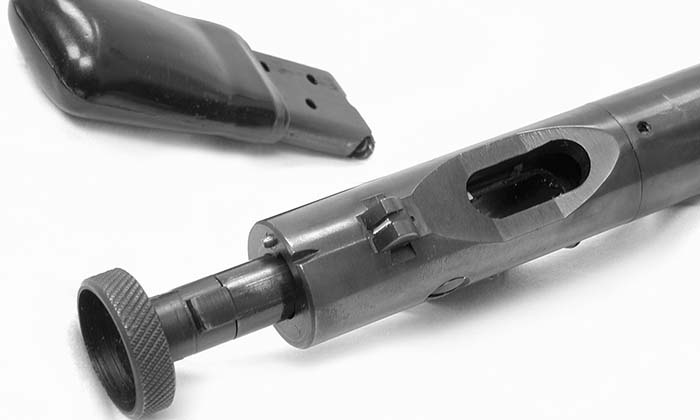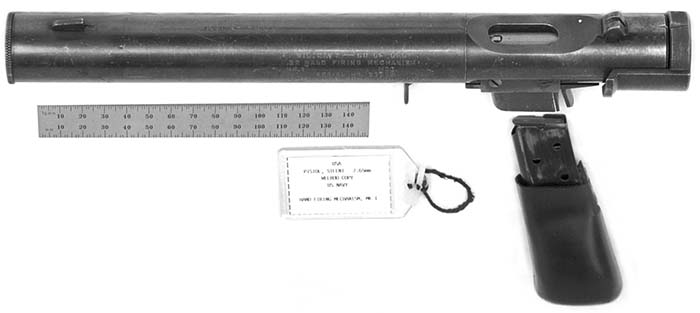By Philip H. Dater, MD
World War II brought new challenges along with changes in the art of warfare. These changes required the development and perfection of new tools, including cryptography advances, radar, rockets, aircraft, and both large and small arms. Clandestine services expanded, and they needed highly specialized tools. Of the free world, subsequently referred to as the Allies, the initial burden was borne by the British. Specifications were created by the Special Operations Executive, the forerunner of the SAS.

Born of necessity and requirements of the SOE, the Welrod silenced pistol was created to fulfill a need for an exceptionally quiet, easily concealed, and highly lethal assassination handgun. Designed around the standard European police cartridge, the 7.65×18 mm (.32ACP), the Welrod was a magazine fed, locked breech, manually loaded, integrally suppressed weapon for use at extremely close ranges. The weapon featured a ported barrel surrounded by wire mesh followed by a suppression chamber filled with stacked flat washer-type baffles and wipes with the wipes placed at intervals among the baffles. The original wipes were oiled leather, but it was found that the oil smoked too badly. Subsequent wipes were felt, cork, or a rubber material. The exit endcap was recessed and had a terminal wipe. The purpose of the recessed end cap was to allow space for the wipe to expand when the weapon was pressed against the target’s body, making the target a part of the suppression system.

There is some debate as to the origin of the name, “Welrod.” Originally referred to as the Hand Firing Device, J. David Truby offers two possible explanations of the nickname, Welrod. One is that it was developed near Wells, and in deference to the OSS and American slang of “rod” for gun, it became known as the “Welrod.” The other relates to England’s Welwyn Herts Laboratory where a number of clandestine weapons were developed for Britain’s SOE. The real name of the actual designer remains cloaked in British secrecy, even to this day. Actual production was performed under great secrecy at Birmingham Small Arms Company in Small Heath, Birmingham, UK.
Built primarily in caliber 7.65mm (Mk-2), a limited number of Welrods were also built in the standard 9mm military cartridge (Mk-1). Reports indicate that subjectively the 7.65mm version was considerably quieter than the 9mm. The Welrod has been built by a number of countries (including the United States), but the vast majority are British. Usually the weapon either had no markings whatsoever or perhaps carried a serial number. The reason for a paucity of markings was official deniability. The exception are the ones built in the United States, which had multiple lines of markings including description, model, caliber, actual manufacturer (and location) as well as stock number. (Dan’s note: The Brits consider this “Absolutely Brilliant!”; a supersecret clandestine weapon with all the info on it! Crazy Yanks!)
Although the Welrod originated in Great Britain, it was subsequently manufactured by several other countries, including the United States. The degree of suppression has been described as essentially totally silent by both users and observers.
In our latest expedition to the United Kingdom, the SAR Expeditionary Force recently had the opportunity to not only fire two original Welrod pistols but to also do accurate sound measurements. To the best of our knowledge, no accurate objective sound pressure level measurements of the Welrod were available or had been performed with modern MIL-SPEC sound measuring equipment.
We are deeply indebted to Gregory Felton of Law Enforcement International, Ltd. for providing the weapons, ammunition, sound meter, and range facilities outside of London for the testing.
Although weekend London traffic is bad, weekday traffic is abominable. It is even more difficult for Yanks in that we had to get used to driving on the other side of the road. Arriving somewhat later than expected at the LEI offices, we chose a number of weapons for testing, including two different Welrod pistols in caliber 7.65 mm. Both were of British origin and neither had any markings or serial numbers, which is typical. One was in absolute original condition, although it had been fired previously and the wipes were both used and brittle. The other had new wipes installed. LEI has a Larson-Davis Laboratories 800B sound level meter with the correct LDL 2530 microphone and a LDL CA-250 calibrator. The meter also included a RS-232 interface, enabling us to drive the meter with a laptop computer to rapidly acquire, record, and analyze the data.
After packing the car, we were more than happy to let Greg Felton navigate London traffic and head for the range. Although the day started sunny, the forecast was for heavy rain and high winds. We left under threatening skies, and once on the motorway, Greg treated us to an example of how to get to the range in minimal time. Shooting in the United Kingdom is far different than in the US, and shooting can only be performed at a registered range with a written log kept of calibers and shots fired. The range LEI had reserved was privately owned and was located on a farm about an hour and a half drive from London, even at speeds of 125 mph. Originally part of a WW-II Allied air strip, the range had been used to test the machine guns on Spitfire aircraft. The remains of the airstrip were subsequently returned to farmland with a current crop of rye. The owner, a shooter and foxhunter himself, maintained the range.

P. Dater Photo courtesy MOD Pattern Room.
Upon arriving and posting the required signs along the road and warning red flags, we set up the meter, calibrated it, and prepared for shooting. Although breezy and threatening rain, the windscreen on the microphone prevented wind noise contamination of the readings. The temperature was 20° C (70° F), the humidity approximately 80%, and the barometric pressure 740 mmHg. Not having a test stand similar to the one I use in Idaho or what Al Paulson uses, we improvised using a 1-meter blue ribbon for spacing the muzzle from the microphone, which was attached to a camera tripod. I operated the meter and laptop, Greg Felton was the shooter, and Dan Shea carefully checked position and alignment prior to each shot. Dan also was the official photographer.
The protocol used was that described in the August 2000 issue of Small Arms Review, “Firearms Sound Measurement Techniques” and met the requirements of MIL-STD-1474C as applied to small arms fire. We made all measurements with the microphone located 1 meter to the left of the muzzle at right angles to the bore axis. Although normal testing protocol is for averaging a string of 10 shots, we abbreviated the string to five shots. This was primarily because of the rarity and age of the weapons. All of the measurements were made in a 15-minute period.

P. Dater Photo courtesy MOD Pattern Room.
There is no such thing as a non-suppressed Welrod, and for non-suppressed measurement data, we used a Walther PP pistol in 7.65mm with a barrel 1/2 inch longer than normal. We subsequently used this same weapon to measure the weapon’s LEI manufactured suppressor, the subject of another article. The average of five shots non-suppressed was 156.8 dB with less than 0.2 dB variation between the shots.
Following non-suppressed measurements of the cartridge, we tested the original Welrod. This weapon, almost 50 years old, dated to World War II. It was completely original (including the wipes and internal meshes) and had seen considerable usage. The wipes in the front end cap were brittle and fairly well shot out, and I suspect they were worn enough that the projectile didn’t even touch the wipes. Measurements were not quite as fast as with a semi-automatic weapon, because the bolt had to be manually cycled after each shot. Although no hearing protection was required and the sound levels were not uncomfortable, the degree of suppression subjectively was less than what one would expect. Metering confirmed this impression with the average of five shots being 142.4 dB, a reduction of only 14.4 dB as compared to the non-suppressed Walther reference weapon. In spite of the weapon being well used and well worn, there was virtually no first round pop and little shot-to-shot variation.
Our next test weapon was Greg’s other Welrod, also caliber 7.65mm. Although this weapon dated to the same mid-1940s period, it had been restored to original condition with new wipes that occluded the bore passage completely, Greg assured us that all the internal parts had been refurbished in a similar manner. The difference was dramatic, and subjectively this Welrod was “Hollywood quiet.” The actual objective sound measurements showed an average of five rounds to have a sound level of 122.8 dB with no first round pop and with no shot more than 1 dB from the average. Compared to the non-suppressed Walther, the reduction was 34.2 dB. The weapon sounded quieter than a CO2 pellet pistol!
There were several other early sound measurements performed in the United States, including at Aberdeen in 1966 and by Frankfort Arsenal in 1968. To the best of my knowledge, these did not include non-suppressed measurements. Although the best available at the time, the equipment used would not meet current specifications required by MIL-STD-1474C. The Frankfort Arsenal measurement location was 5 meters to the side of the muzzle while the current preferred location is 1 meter to the left of the muzzle. I do not know the Aberdeen test protocol. Most of the sound pressure levels were not totally believable, even when calculating the differences due to differing microphone locations. Undoubtedly this was a function of the available measuring equipment (including excessive meter rise time).

P. Dater Photo courtesy MOD Pattern Room.
Although the sound meter as an objective measurement is an important benchmark, it does not tell the entire story. There are a number of air (pellet) pistols with similar sound levels and some integrally suppressed .22 rimfire pistols with a slightly lower sound level. The subjective evaluation of the Welrod is that it makes less noise than these other weapons. Part of the reason is the locked breech. Although left-of-muzzle measurements of the .22-rimfire weapons may meter a lower sound level, subjectively they are louder due to right-hand ejection port noise. Further, the Welrod, with its wipes, significantly changes the sound characteristic with elimination of virtually all the higher frequency sounds. The sound of the Welrod being fired in a quiet location is almost imperceptible at 15 feet. In a noisy environment and with the muzzle in actual contact with the intended target, it would be inaudible even to the operator.
In the opinion of the members of the SAR Expeditionary Force, the Welrod achieved its design goals as an easily concealed, lethal assassination weapon. We can easily understand why it is still classified as an operational weapon even 60 years after its inception.
We are deeply indebted to Greg Felton and Law Enforcement International, Ltd. of London, UK for providing us the weapons, facilities, time, and great companionship for these tests.
References:
Dater, Philip, “Sound Measurement Techniques,” Small Arms Review, V. 3 No. 11, Aug 2000
Truby, J. David, “The Ugliest 60 Year Old Gun I Ever Saw,” Small Arms Review, V. 2 No. 4, Jan 1999
Truby, J. David, Silencers, Snipers & Assassins, Palladin Press, 1972
| This article first appeared in Small Arms Review V5N11 (August 2002) |











